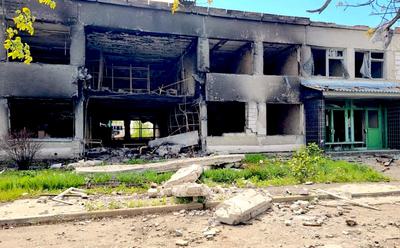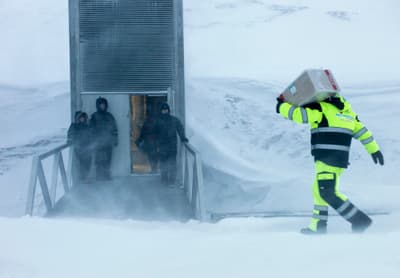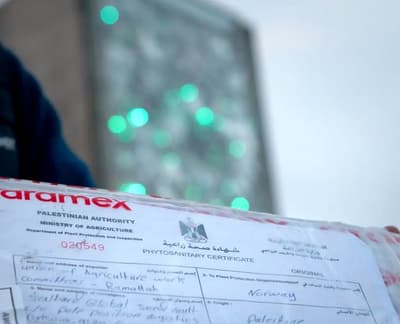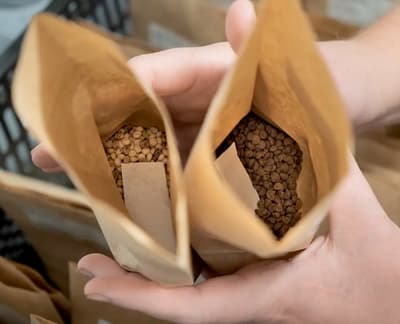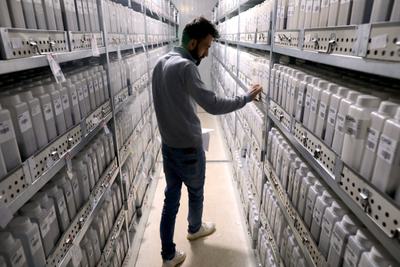When scientists returned to Sudan’s seed bank after it was invaded by rebel forces, they found the seeds scattered.
But in December 2023, soon after the start of the current Sudanese civil war, the rebel RSF group invaded the bank, forcing its staff to flee. When the scientists returned 13 months later, they found its freezers empty and the seeds scattered.
Sudan’s plant genetic resources director Ali Babiker gathered what he could from seeds held at another research station in the northern city of Elobeid, which had itself been under siege. In February this year, he dispatched those seeds for safekeeping to Svalbard. But currently only about a quarter of the war-ravaged country’s irreplaceable seed collection has been retrieved, catalogued, and sent to the northern ice store.
Ukraine has a similar story to tell. It has long been one of the world’s breadbaskets. Until the Russian invasion in 2022, it was a major exporter of grain, its productivity underpinned by plant breeding from seed stock held at the national gene bank in Kharkiv. One of the world’s 10 largest seed banks, it contained thousands of unique varieties of wheat, rapeseed, and other crops.
But Kharkiv has been a frontline city in the conflict, and in May 2022 Russia shelled the seed bank’s buildings and research fields. Thankfully, most of the collection survived, and afterward researchers moved it to a new, secret location in the west of the country. But Viktor Ryabchun, head of the National Center of Plant Genetic Resources, says that some of their planted collections remain behind enemy lines.
Damage from a 2022 Russian attack on the Yuriev Plant Production Institute, site of the National Center of Plant Genetic Resources, in Kharkiv, Ukraine. Serhiy Avramenko
“We are working to duplicate the gene pool,” he says. An agreement was reached last year for Ukraine to belatedly join the 2001 international treaty for sharing plant genetic resources and to transfer seeds to Svalbard. But neither has yet happened, leaving the collection in continued peril. Of the country’s 154,000 samples of crop varieties, a quarter of which are found only in Ukraine, just 2,780 currently have duplicates stored in Svalbard.
Palestinian seeds are doing better. The main seed bank in Hebron contains local varieties of tomatoes, cucumbers, eggplants, zucchini, and much else collected from farms on the West Bank and Gaza. It has been maintained since 2003 by researchers from the Union of Agricultural Work Committees (UAWC), a nonprofit that aims to “preserve Palestinian crops for future generations, considering the escalation of Israeli encroachments.”
In 2021, Israel designated the UAWC a terrorist organization for alleged links to the Popular Front for the Liberation of Palestine and shut its offices in Ramallah. But the U.N. and the European Union have not endorsed the charge and maintain contacts. The Hebron seed bank, which continues its work, “is a very valuable collection, located in a region where many crops were first domesticated,” says Hawtin. “It contains material that could make an invaluable contribution to agriculture in the region and the world.” Last October, Svalbard received its first Palestinian samples from the bank.
The Svalbard vault provides deep-freeze storage of seeds capable of restocking the world’s fields if a global disaster occurs.
The world’s first seed bank was established in Russia by the renowned agronomist and seed explorer Nikolai Vavilov in 1921. A century on, most nations now have national seed banks, backed up by 11 international banks run under a partnership known as CGIAR (formerly the Consultative Group on International Agricultural Research), which is funded largely by national governments.
Concern about the security of these facilities led Hawtin and others to propose a second global backup to secure collections against wars, insurrection, climate change, plant plagues, and other catastrophes at seed banks. That facility opened in Norway in 2008 in a cavern excavated in permafrost outside Longyearbyen, the capital of Svalbard. It now contains several hundred million seeds, representing more than 1.3 million varieties of more than 6,000 species, collected from 87 countries.
The latest additions, made this month, include British brassicas, Korean adzuki beans, a thousand rice samples from Vietnam, and from Benin samples of fonio, known in West Africa as the cereal of the poor.
Seeds being delivered to the Svalbard Global Seed Vault in Norway. Matthias Heyde / Svalbard Global Seed Vault
In the past year, Svalbard also took duplicate seeds from the Philippine national gene bank at Los Banos, which has lost more than half its collection twice in recent years: first to a typhoon in 2006, and then to a fire in 2012. And Chad sent its first deposits, more than a thousand samples of sesame, rice, maize, and sorghum. Adapted to Chad’s harsh desert climate, they are regarded as crucial for breeding future crops that can withstand increasing temperatures and erratic rainfall.
Other valuable genetic attributes that plant breeders hope the Svalbard vault is protecting for the future include resistance to novel diseases and pests. And as a “doomsday vault,” they see it as providing a deep-freeze seed store capable of restocking the world’s fields in the event of a major global disaster such as an asteroid hit or seismic catastrophe such as a super-volcano or nuclear war.
Since settled agriculture began some 10,000 years ago in the Middle East, farmers have bred and planted millions of different varieties of crops to suit local conditions. From the 1960s, scientific methods of plant breeding have drastically narrowed down this traditional cornucopia. Most farms now grow only a handful of varieties engineered to maximize yields in response to inputs such as fertilizer and irrigation water.
“If you look on the map of the centers of origin of crops, you will see that many of those are in areas that today are conflict zones.”
That transformation, known as the Green Revolution, has kept the world’s rising population fed. But many of the old varieties, with their often-unique attributes, are now either lost or confined to research labs and seed banks.
This creates a dangerous paradox, says Hawtin. To maintain the productivity of the new varieties, while fighting off pests and responding to changing climate, plant breeders need a constant supply of genes with valuable traits that are often found only in the abandoned varieties. That dependence is only likely to increase as a changing climate requires crops to adapt to new environmental challenges and as technological advances provide new opportunities to incorporate the genes from traditional plants into new breeds, he says. “With modern biotechnologies, digital systems and A.I., seed collections will become ever more important as a source of genomic information.”
The risks of losing the invaluable genetic traits stored in traditional seeds are all the greater because many of the most important seed collections are often in run-down seed banks in genetic heartlands of the world’s major crops that are under constant threat from wars, notably in the Middle East.
Left: A shipment of seeds from the West Bank arrives at the Svalbard Global Seed Vault. Right: Grains of sorghum and roselle from Sudan are prepared to be deposited in the vault. NordGen
“If you look on the map of the centers of origin of crops, you will see that many of those are in areas that today are conflict zones,” says Ola Westengen, an agrodiversity researcher at the Norwegian University of Life Sciences.
The mountains of Afghanistan, for instance, originated a wide range of globally important crops from early forms of wheat and barley to vegetables such as carrots and radishes, nuts such as almonds and walnuts, and fruits such as grapes, melons, and figs. Once these seeds were kept secure, but since the 1970s, all the country’s agricultural research stations have been bombed, looted, abandoned, or confiscated by warlords. The national seed bank collection outside Kabul succumbed to fighting between Mujahideen factions in 1992.
Since then, researchers have repeatedly tried to restore their collections, even hiding them in remote houses only to return to find these secret stashes looted and the seeds strewn unlabeled on the ground. “It was like having a library of books with no titles on them. All of the [genetic traits] are there, but you no longer know where to look for them,” says Hawtin. In 2021 the government of Ashraf Ghani invited bids to build a new gene bank. But months later, his overthrow by the Taliban put an end to that.
The U.N. plans to rehabilitate the Abu Ghraib seed bank in Iraq and build a new seed bank in the country’s Kurdish region.
Sometimes, plant scientists are more successful. In 1996, fearing the worst as the U.S. launched missile strikes on Iraq, plant breeders at the national seed bank in Abu Ghraib packed up their most irreplaceable samples and secretly shipped them across the border to the main seed bank of the International Center for Agricultural Research in the Dry Areas (ICARDA), part of the CGIAR network, outside Aleppo in Syria.
It proved a fortuitous decision. Following the U.S. invasion of Iraq in 2003, the country descended into chaos and the Abu Ghraib seed bank was destroyed. The shipment to Aleppo proved to be “a genetic time capsule containing Iraq’s agricultural heritage,” ICARDA’s then research director William Erskine told me during a visit two years later.
Then came the civil war in Syria. Recognizing their likely fate, savvy ICARDA staff spent three years quietly moving more than 100,000 samples of its Middle East genetic treasures — 80 percent of the collection, including wheat, barley, chickpeas and lentils — to the Svalbard vault, before Islamic State jihadists overran the bank in 2013.
The ICARDA gene bank in Bekaa Valley, Lebanon, is stocked with seeds from a bank in Aleppo, Syria. Marwan Tahtah / Getty Images
Since then, most of the seed samples sent to Svalbard have been retrieved and relocated to ICARDA gene banks in Morocco and Lebanon that aim to breed a new generation of drought-tolerant grain crops. Some ancient wild relatives of modern wheat in the Syrian collection have since been used to help Midwest wheat varieties withstand an epidemic of Hessian flies.
Other besieged national collections have begun to recover. Yemen lost one of its main seed stores to a Saudi air strike on Al-Kadan in 2016, losing some unique sorghum varieties. But since 2020, it has built two new banks. Meanwhile, the U.N. Food and Agriculture Organization last year announced plans to rehabilitate the Abu Ghraib seed bank in Iraq, and in February this year invited bids to build a new gene bank in the Kurdish region of the country, thought to be the home of many heirloom varieties of wheat.
But some crop scientists fear that the days of international cooperation, when governments were keen to maintain their national seed collections and back them up in the CGIAR international seed banks and at Svalbard, may be drawing to a close. “Recently, lack of trust in international collaboration and the incredible reduction in funding from rich countries is jeopardizing relationships,” says Charlotte Lusty, head of collecting at the Millennium Seed Bank in the U.K.
Deteriorating international relations have made some governments wary of sending their most precious seeds abroad.
The world’s largest seed collection outside Svalbard, run by the U.S. Department of Agriculture’s National Laboratory for Genetic Resource Preservation at Fort Collins, Colorado, experienced staff cuts ordered by the so-called Department of Government Efficiency in February. Some people, including its director, were reinstated by court order, but future funding for the collection remains uncertain. A similar cloud hangs over the CGIAR seed-bank network, whose largest funder until now has been USAID, which faces funding cuts on overseas aid of up to 90 percent.
Meanwhile, deteriorating international relations have made some national governments wary of sending their most precious seeds abroad — even to ultra-secure Svalbard, where nobody can enter other than technicians making deposits.
Norway may still be regarded as a good guarantor of seed sovereignty. But Russia has a long-standing settlement there, where its residents recently conducted military-style parades. Meanwhile Vladimir Putin has accused Norway of militarizing the archipelago by allowing visits by its naval frigates. Such saber-rattling “follows Moscow’s playbook in Ukraine,” says Elisabeth Braw, a senior fellow at the Atlantic Council, an American think tank. The concern is that Russia’s plans to expand its activities in the Arctic may one day include territorial ambitions at Svalbard.
Other analysts doubt this, however. But if such fears escalate, Ukraine and other nations could become nervous about depositing their seeds in Svalbard. It would be a tragedy if the geopolitical ambitions of Russia, the country that established the first seed banks to protect world food supplies, should end up undermining that ambition.
